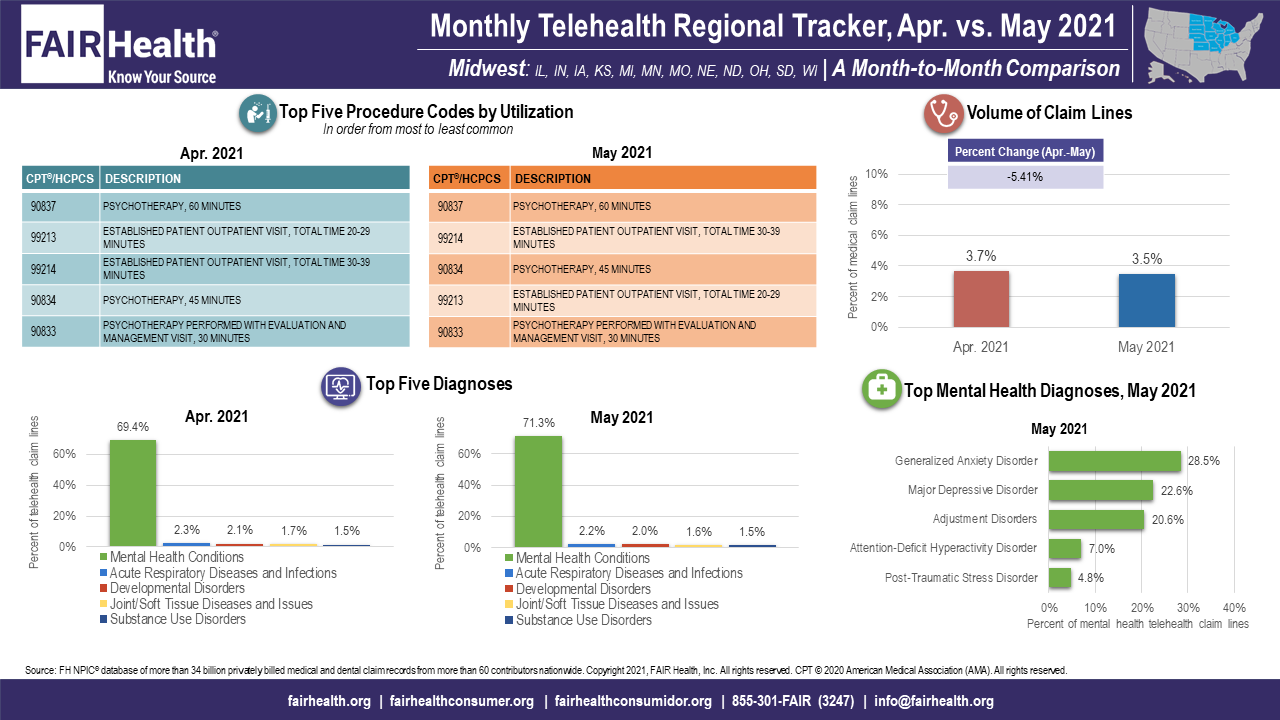- Center on Health Equity & Access
- Clinical
- Health Care Cost
- Health Care Delivery
- Insurance
- Policy
- Technology
- Value-Based Care
After 3 Months of Decline, Telehealth Utilization Stabilizes in May 2021
Telehealth utilization stabilized in May 2021 after a 3-month drop, according to FAIR Health’s Monthly Telehealth Regional Tracker. Robin Gelburd, JD, president of FAIR Health, discusses the stabilization of telehealth utilization in May 2021 after a 3-month drop.
After 3 months of decline, telehealth utilization stabilized in May 2021, according to FAIR Health’s Monthly Telehealth Regional Tracker. Telehealth utilization, measured as a percentage of all medical claim lines, rose 2% nationally from April to May 2021, increasing from 4.9% of medical claim lines in April to 5% in May (Exhibit 1). By comparison, telehealth claim lines fell nationally as a percentage of medical claim lines each month from February to April. The data represent the privately insured population, including Medicare Advantage and excluding Medicare fee-for-service and Medicaid.
Exhibit 1. Monthly Telehealth Regional Tracker, April versus May 2021, United States

(Source: FAIR Health)
In 2 of the 4 US census regions in May 2021, telehealth claim lines rose as a percentage of medical claim lines just as they did nationally — 5.6% in the South and 4.8% in the West. In the other 2 regions, there was a decrease — 5.4% in the Midwest and 1.7% in the Northeast.
In May 2021, substance use disorders joined the top 5 telehealth diagnoses nationally for the first time, in fifth place. Substance use disorders also remained in the top 5 in the Midwest and Northeast, as had been the case in April. The pattern was consistent with reports of increased misuse of opioids and stimulants during the COVID-19 pandemic.
The percentage of telehealth claim lines accounted for by mental health conditions rose nationally and in every region in May 2021. Mental health conditions remained in the number one spot among telehealth diagnoses nationally and in every region.
Acute respiratory diseases and infections climbed in the national rankings of telehealth diagnoses from number 4 to number 3, joining the top 5 diagnoses in the Northeast and West. The diagnosis had already been in the top 5 in the Midwest and South in April, and continued there in May. As in April, this suggested a return to non-COVID respiratory conditions, such as colds and bronchitis, as cases of COVID-19 fell.
In May 2021, the top 5 telehealth procedure codes by utilization remained the same as in April nationally and in every region but the Midwest (Exhibit 2). There, CPT®[2] 99213, an established patient outpatient visit with a total time of 20-29 minutes, fell from second to fourth place.
Exhibit 2. Monthly Telehealth Regional Tracker, April versus May 2021, Midwest

(Source: FAIR Health)
About the Monthly Telehealth Regional Tracker
Launched in May 2020 as a free service, the Monthly Telehealth Regional Tracker uses FAIR Health data to track how telehealth is evolving from month to month. An interactive map of the four US census regions allows the user to view an infographic on telehealth in a specific month in the nation as a whole or in individual regions. Each infographic shows month-to-month changes in volume of telehealth claim lines, top 5 telehealth procedure codes and top 5 telehealth diagnoses (or diagnostic categories), along with that month’s top 5 granular diagnoses within the most common diagnostic category.
FAIR Health’s Monthly Telehealth Regional Tracker continues to reveal changes in telehealth as the COVID-19 pandemic evolves. This is one of many ways we pursue our healthcare transparency mission.
For the Monthly Telehealth Regional Tracker, click here.
Robin Gelburd, JD, is the founding President of FAIR Health, a national, independent nonprofit organization that serves as a trusted leader in healthcare cost transparency, data analytics and benchmarks. FAIR Health possesses the nation’s largest collection of private healthcare claims data, which includes over 34 billion claim records and grows at a rate of over 2 billion claim records a year. Certified by the Centers for Medicare & Medicaid Services as a national Qualified Entity, FAIR Health also receives data representing the experience of all individuals enrolled in traditional Medicare Parts A, B and D. Robin is a nationally recognized expert on healthcare policy and health literacy and transparency. Selected as one of Crain’s 2019 Notable Women in Health Care, she has been invited to speak to organizations and federal and state agencies across the country and world.
[2] CPT © 2020 American Medical Association (AMA). All rights reserved.
